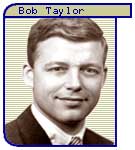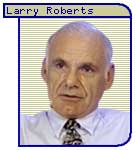 |
|||
 |
|||
From the terminal room next to his Pentagon office, Bob
Taylor had a direct connection to several of the ARPA-funded computers
around the country. Each terminal was connected to a single computer
and Taylor needed to use a different login sequence and different commands
on each mainframe. In
1966, it was the leading edge of
computer networking, but Taylor was tired of changing seats and instructions
every time he needed to communicate with another computer.
He composed an idea and walked to his boss's office, Charles
Herzfeld, and gave him the pitch. Taylor explained the problem and
described a vague solution about networking different computers together.
Herzfeld liked the idea and said Taylor had one million dollars to make
the idea work. When Taylor looked at his watch he noted that it only took
twenty minutes to get the project funded.
One of the sayings at ARPA was "why don't we rely on
the computer industry to do that?" instead of the government. So, Bob
Taylor started writing a Request for Proposals titled "Cooperative Network
of Time-Sharing Computers." He described the general idea, but he needed
some help figuring out what they were asking contractors to do, exactly.
The best person he knew who could help him was
Larry Roberts, who was
working at MIT's Lincoln Lab networking computers like the TX-2. Roberts
had just built and tested the first transcontinental network between
two computers, so he had as much experience as anyone in long-distance
networks.
At the next annual conference of ARPA-funded university projects, Roberts
organized a meeting to talk about the project. Two important parts of
the network were decided: that the network traffic between computers would
be broken up into blocks (a packet-switched network), and that a separate
computer would act as a gateway to the network for each node. This computer,
named an
Interface Message Processor (IMP),
would be connected to the network and to a mainframe at the site. All the nodes
would have nearly identical IMPs, creating a standard interface for the network
between nodes.
![]() Twenty Minute
Pitch
Twenty Minute
Pitch
 Early
in the space-race, NASA was paying for a lot of research and it employed
thousands at its growing research centers.
Robert Taylor, a young scientist
who studied psychoacoustics and mathematics at the University of Texas,
worked for NASA as a research administrator in the early 1960's. After
a few years at NASA, he was hired by Ivan Sutherland, the second director
of IPTO, in
1965 to work at ARPA. Only one year
later, Taylor succeeded Sutherland as director and managed all the computer
projects funded by ARPA.
Early
in the space-race, NASA was paying for a lot of research and it employed
thousands at its growing research centers.
Robert Taylor, a young scientist
who studied psychoacoustics and mathematics at the University of Texas,
worked for NASA as a research administrator in the early 1960's. After
a few years at NASA, he was hired by Ivan Sutherland, the second director
of IPTO, in
1965 to work at ARPA. Only one year
later, Taylor succeeded Sutherland as director and managed all the computer
projects funded by ARPA.  At first, Roberts had no interest in leaving MIT, but Taylor wouldn't
take no for an answer. Since he was in charge of funding over half
of the research at Lincoln Lab, he had some clout there. After over
a year of asking, Charles Herzfeld called Roberts' boss and strongly
suggested he help Roberts decide to take the job. The director of Lincoln
Lab called Roberts into his office and made the suggestion that the
position at ARPA might be a good career choice at that time. Roberts
moved to ARPA in 1966 and began drafting the Request for Proposals
that ARPA would send out to potential contractors.
At first, Roberts had no interest in leaving MIT, but Taylor wouldn't
take no for an answer. Since he was in charge of funding over half
of the research at Lincoln Lab, he had some clout there. After over
a year of asking, Charles Herzfeld called Roberts' boss and strongly
suggested he help Roberts decide to take the job. The director of Lincoln
Lab called Roberts into his office and made the suggestion that the
position at ARPA might be a good career choice at that time. Roberts
moved to ARPA in 1966 and began drafting the Request for Proposals
that ARPA would send out to potential contractors.
Copyright © 1998, PBS Online,
Inc. All Rights Reserved.
Site Designed and Developed by
OPB Learning Media